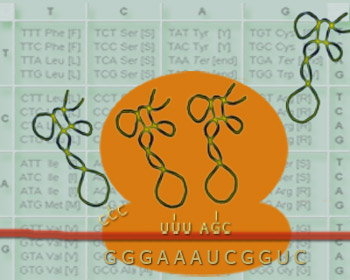Concept 22 DNA words are three letters long.

The genetic code had to be a "language" — using the DNA alphabet of A, T, C, and G — that produced enough DNA "words" to specify each of the 20 known amino acids. Simple math showed that only 16 words are possible from a two-letter combination, but a three-letter code produces 64 words. Operating on the principle that the simplest solution is often correct, researchers assumed a three-letter code called a codon.
Research teams at University of British Columbia and the National Institutes of Health laboriously synthesized different RNA molecules, each a long strand composed of a single repeated codon. Then, each type of synthetic RNA was added to a cell-free translation system containing ribosomes, transfer RNAs, and amino acids. As predicted, each type of synthetic RNA produced a polypeptide chain composed of repeated units of a single amino acid. Several codons are "stop" signals and many amino acids are specified by several different codons, accounting for all 64 three-letter combinations.
 DNA and proteins are key molecules of the cell nucleus.
DNA and proteins are key molecules of the cell nucleus. One gene makes one protein.
One gene makes one protein. A gene is made of DNA.
A gene is made of DNA. Bacteria and viruses have DNA too.
Bacteria and viruses have DNA too. The DNA molecule is shaped like a twisted ladder.
The DNA molecule is shaped like a twisted ladder. A half DNA ladder is a template for copying the whole.
A half DNA ladder is a template for copying the whole. RNA is an intermediary between DNA and protein.
RNA is an intermediary between DNA and protein. DNA words are three letters long.
DNA words are three letters long. A gene is a discrete sequence of DNA nucleotides.
A gene is a discrete sequence of DNA nucleotides. The RNA message is sometimes edited.
The RNA message is sometimes edited. Some viruses store genetic information in RNA.
Some viruses store genetic information in RNA. RNA was the first genetic molecule.
RNA was the first genetic molecule. Mutations are changes in genetic information.
Mutations are changes in genetic information. Some types of mutations are automatically repaired.
Some types of mutations are automatically repaired.